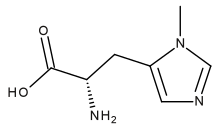3-Methylhistidine

| |
| Names | |
|---|---|
| Systematic IUPAC name
(2S)-2-Amino-3-(1-methyl-1H-imidazol-5-yl)propanoic acid | |
| Identifiers | |
3D model (JSmol)
|
|
| 83651 | |
| ChEBI | |
| ChEMBL | |
| ChemSpider | |
| ECHA InfoCard | 100.006.095 |
| EC Number |
|
| 1568650 | |
| KEGG | |
PubChem CID
|
|
| UNII | |
CompTox Dashboard (EPA)
|
|
| |
| |
| Properties | |
| C7H11N3O2 | |
| Molar mass | 169.184 |
| 200 mg/mL at 25 °C[1][2] | |
| Hazards | |
| GHS labelling: | |

| |
| Warning | |
| H315, H319, H335 | |
| P261, P264, P271, P280, P302+P352, P304+P340, P305+P351+P338, P312, P321, P332+P313, P337+P313, P362, P403+P233, P405, P501 | |
Except where otherwise noted, data are given for materials in their standard state (at 25 °C [77 °F], 100 kPa).
| |
3-Methylhistidine (3-MH) is a post-translationally modified amino acid which is excreted in human urine.[1][2] Urinary concentration of 3-methylhistidine is a biomarker for skeletal muscle protein breakdown in humans who have been subject to muscle injury.[1][3][4] Urinary 3-methylhistidine concentrations are also elevated from consumption of soy-based products and meat, particularly chicken.[1]
Biochemistry
[edit]3-Methylhistidine is a metabolic product that is produced in the body via the enzymatic methylation of histidine during peptide bond synthesis and the methylation of actin and myosin.[1][2]
Detection in body fluids
[edit]The normal concentration of 3-methylhistidine in the urine of healthy adult humans has been detected and quantified in a range of 3.63–69.27 micromoles per millimole (μmol/mmol) of creatinine, with most studies reporting the average urinary concentration between 15–20 μmol/mmol of creatinine.[1] The average concentration of 3-methylhistidine in human blood plasma has been detected and quantified at 2.85 micromolar (μM) with a range of 0.0–5.9 μM.[1] The average concentration of 3-methylhistidine in human cerebrospinal fluid (CSF) has been detected and quantified at 3.82 μM with a range of 1.39–6.25 μM.[1]
References
[edit]- ^ a b c d e f g h "3-Methylhistidine". HMDB Version 4.0. Human Metabolome Database. 20 December 2017. Retrieved 25 December 2017.
- ^ a b c "3-Methyl-L-histidine". PubChem Compound. United States National Library of Medicine – National Center for Biotechnology Information. 23 December 2017. Retrieved 25 December 2017.
- ^ Chinkes DL (September 2005). "Methods for measuring tissue protein breakdown rate in vivo". Current Opinion in Clinical Nutrition and Metabolic Care. 8 (5): 534–537. doi:10.1097/01.mco.0000170754.25372.37. PMID 16079625. S2CID 8318490.
- ^ Holm L, Kjaer M (September 2010). "Measuring protein breakdown rate in individual proteins in vivo". Current Opinion in Clinical Nutrition and Metabolic Care. 13 (5): 526–531. doi:10.1097/MCO.0b013e32833c3c64. PMC 3008417. PMID 20616712.
Text is available under the CC BY-SA 4.0 license; additional terms may apply.
Images, videos and audio are available under their respective licenses.
